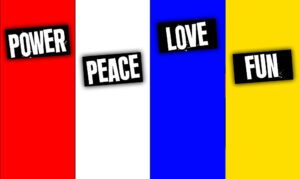What is the Yellow Color Code Personality Type?
The Yellow Color Code Personality Type is motivated by Play. They want to have fun and are considered “The life to be a party.”
Yellow Personality Type cross-reference
- Keirsey Type – Artisans
- Temperament Type – Sanguine
- Animal Type – Golden Retriever
- DISC Type – Steadiness
- Socio-Communicative Type – Amiable
- True Colors – Orange
- Personality Compass – South
- Occupational Type – Conventional
- Learning Type – Reflector
- Leadership Type – Accommodator
MBTI Personality Types (xSxP) – Sensing and Perceiving
Enneagram Types
- Type 2 – The Helper (ESFP, ISFP)
- Type 6 – The Loyalist (All Sensing)
- Type 7 – The Enthusiast (ESTP, ESFP)
- Type 9 – The Peacemaker (ISFP)
Yellow Personality Type Careers
What are the Color Code Personality Types?
Dr. Taylor Hartman created The Color Code Personality Type, or The People Code, which classifies Personality Types by Core Motives.
It helps you understand an individual’s motives and the “Why people do what they do” to gain insight into people’s behavior and build more effective relationships with the people you interact with regularly.
The system helps you recognize your innate strengths and limitations and shows you how to use those traits in your personal and professional life.
The Color Code Personality Type system is similar to the four core Personality Temperaments. Still, it focuses more on the individual’s core motivations.

Personality Temperaments, Traits, and Types
Personality Temperaments, Personality Traits, and Personality Types are used in Psychology to discuss a person’s Personality, a collection of Emotions, Perceptions, and Actions that interact with each other, regulate themselves, and shape a dynamic system that forms a person’s Behavioral Patterns.
Your inherited traits (your personality Temperance) and acquired traits (such as education, socialization, and other various pressures and aspects) form your Personality.
A Personality Type identifies a specific collection of Traits, both learned and natural, that comprise a broad, general Personality Classification—a way of labeling a collection of traits and behaviors.
A Personality Trait remains consistent and stable over time, which means you exhibit the same pattern across different situations and throughout your life.
Three criteria characterize Personality Traits: (1) consistency, (2) stability, and (3) individual differences. For example, if you are talkative at home, you also tend to be talkative at work. And if you were talkative at age 20, you would still be chatty at age 40.
Personality Temperament is your “Naturally Intuitive” biological Trait. These Traits are partly inherited from your genes and partially determined by your brainstem, which doesn’t change throughout your life. These are Natural Traits regarded as innate or inborn and not learned.
Your Personality Temperament is formed as an infant and is hard to modify, manipulate, or change because it is genetic. In some way or another, your inherited behavioral tendency will always be there.
Personality Traits are quantitative differences between people, and Personality Types are qualitative differences between people. The most crucial difference between the Trait Theory and the Type Theory is that the Type Theory views people’s characteristics as discrete categories, while the T. In contrast,eory views these characteristics as a continuum.
For example, while a Type Theorist would claim that introverts and extraverts are two types of people, a Trait Theorist claims that extraversion is a gradient, and individuals can fall somewhere in the middle.
Your Temperaments, along with acquired Traits, form your Personality.
Yellow Characteristics

- Yellows love life.
- They appreciate what they have rather than be miserable.
- Yellows bound through life well-focused on themselves.
- They have a most difficult time accepting responsibility for themselves.
- Yellows take the easy path.
- They seek enchanting opportunities and find life laced with silver linings.
- Yellows enjoy life regardless of what they are doing.
- They enjoy the company of others.
- Yellows would like to change not themselves but the world around them.
- They learn early in life to cut corners.
- Yellows are impulsive and restless.
- They find it easy to relate to people of all ages.
- Yellows love to entertain and be entertained.
- They are naïve and trusting.
- Yellows are often nicknamed “chatterbox.”
Yellows welcome praise.
Yellows need to be noticed. Little else improves a relationship with a Yellow more than praise because they need to know they are valued.
Yellows often act like they have the world by the tail, but they have their fears and frustrations—which they rarely confide in until they know they are emotionally safe.
Safety is most effectively evidenced to Yellows through praise.
Yellows need emotional connections.
Yellows often appear so calm that people think they don’t care about anything. But nothing could be further from the truth.
They need a great deal of attention.
Yellows enjoy touching; to them, physical contact is often the most direct, comfortable, intimate connection.
Yellows want to be famous.
The Yellow Personality Type likes to be center stage, and social acceptance is critical.
Friendships command a high priority in their lives because popularity answers one of their essential needs—the need for general approval.
They are highly verbal, can superficially chitchat with the best of them, and relish good conversation, but they can also go with the flow.
Yellows like action.
Quickly bored, Yellows seek adventure. But, unfortunately, they can never sit still for long.
Yellows chooses friends who refuse to let the “boring details” get in the way of the essential things in life—play.
Ironically, numerous people are currently misdiagnosed as having ADD (Attention Deficit Disorder) when, in fact, they are merely Yellow personalities struggling with
Strengths
- Comfortable with people.
- Gives priority to playtime.
- High energy.
- Turns crisis into comedy.
- Strong visual learner.
- Forgiving of self and others.
- They are not burdened with emotional baggage.
- Highly optimistic (rarely depressed).
- Likes self and accepts others readily.
- Loves to volunteer for opportunities.
- Sees life as an experience to be enjoyed.
- Flashy (racehorse rather than plowhorse).
- Adventurous and daring.
- Often places friends before family.
- Forgiving of self and others.
- Lively and entertaining.
- Vulnerable, innocent, and trusting.
- Endearing.
- They are willing to free up the schedule to play.
Weaknesses
- They need to look good socially.
- Often speaks before thinking.
- They feel no need to prepare for the future.
- Sloppy and unpredictable.
- Forgetful.
- Undependable in a crisis.
- They prefer to enter a relationship knowing there is an escape.
- They need to look good socially (high priority).
- Irresponsible and unreliable.
- Self-centered and egotistical.
- Lots of talk with little action.
- Superficial and primarily interested in a reasonable time.
- Unwilling to experience pain to produce quality.
- Undisciplined.
- Loud and obnoxious in public places.
- Exaggerates successes and omits unpleasant trusts.
- Unable to confront or face issues.
- They spend most of the time discussing their own life.
- Shows up at their convenience.
- Undependable in a crisis.
- Unwilling to commit to the long-term needs of distressed friends.
- Pursues win life regardless of friends’ situations or needs.
- Uncomfortable in painful or distressing environments.
- Makes new friends easily and without guilt, often at the expense of old friends.
Yellow Communication style
Do’s
- Be positive and proactive with them in your life.
- Adore and praise them legitimately.
- Touch them physically.
- Accept their playful teasing.
- Remember, they are more sensitive than they appear.
- Value their social interaction skills and people connections.
- Remember, they hold feelings deeply.
- Promote creative and fun activities for and with them.
- Enjoy their charismatic innocence.
- Allow them the opportunity for verbal expression.
Don’ts
- Be too severe or sober in criticism.
- Push them too intently.
- Ignore them.
- Forget that they also have “down” time.
- Demand perfection.
- Expect them to dwell on problems.
- Give them too much rope, or they may hang themselves.
- Classify them as just lightweight social butterflies.
- Attack their sensitivity to being unforgiving.
- Control their schedules or consume their time.

